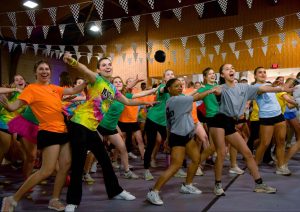The downfall of Alula Arbor
Rapid campus expansion destroys student art installation

Alula Arbor stand on Wake Forest’s campus.
September 7, 2022
In the face of campus expansion, an interactive art installation for environmental awareness has been destroyed to pave the way for a new parking lot.
The installation, Alula Arbor, was a student-led art project intended to give students an isolated space on campus to connect with themselves, others and the natural world around them. The construction is part of an expansion of the university’s athletics complex.
In October 2021, Wake Forest students Marie Claire Goff and Ramona Suris were tasked with creating an art installation for their Public Arts course. Filled with endless creative ideas, Goff ultimately wanted a sustainability-oriented space for students to connect with the peaceful seclusion of nature. Similarly, Suris explored ways to create a mental health space for students to take a break from campus life. The pair’s ideas fit together perfectly, eventually creating the beautiful space once known as Alula Arbor.
Alula Arbor resided near the cross-country trails behind the Miller Center, placed at the top of a hill. “It was on the periphery of campus, purposefully so you can feel like you’re taking a break from campus activity,” Goff said.
The installation began with a walking trail up the hill, lined with painted signs. Each sign displayed an inspirational quote to mark the importance of the environment and connect the audience to the surrounding nature.
“[One sign] read: ‘When the last fish is caught, the last tree cut, and the last river polluted, only then will man realize he can’t eat money.’” Goff said. “It was an ancient Native American saying, and it really adds to the irony of things now,”
After following the signs up the hill, the trail leads to the main portion of the installation: a gathering space around a white oak tree, fondly named Alula. “The semicircle is centered around the main tree, Alula, which means ‘new beginnings’,” Goff said.
Suris recalled establishing this idea of new beginnings with Alula itself, stating, “We knew we wanted to center it around a new tree because that meant rejuvenation and regeneration, a space where there is growth, change, and life.”
“There’s a circle of prayer flags surrounding the area. At the opening of the exhibit, we had everyone write [on the flags] their hopes and dreams for the space, gratitudes for the Earth, or just something they’re looking forward to,” Goff said.
From the flags to the paint, all of the materials used to construct the installation were recycled. The seats were made of old or unusable tires, the paints were unwanted or incorrectly mixed, and the flags were made from recycled papers and fabrics—everything was repurposed.
To retain authenticity for the space, the artists avoided media advertising much as possible. “We didn’t want to have something that was so over-publicized to the point where it didn’t feel authentic. It was just a place where people could feel like they found it on their own and connected with it in their own way.”
Ultimately, Alula Arbor was used for gatherings, class lectures, dates, yoga classes, or just a general space for students to feel at peace with themselves and others. According to Goff, “The goal of the space was to be community-oriented, a space for vulnerability to cultivate genuine connection.”
“I was blown away by students’ interactions with [Alula Arbor]. I found myself up there often, whether to take a rest or bawl my eyes out. And almost every time I went up, there was another person there,” Suris described.
Outdoor spaces such as these are crucial for our connection to the natural world. To the artists, “The space is where you can meditate, take a break, and feel connected to the Earth.” Goff and Suris presented students with an opportunity to reflect on nature’s influence—and, in turn, reflect on our influence on nature.
Then, less than a year after the creation of the installation, construction began.
After pouring time, effort, and love into the project, Goff and Suris were told that the installation was being removed to expand upon the Athletics facilities, a construction project known as the McCreary Addition. In the near future, the space once used for students to find serenity in nature will soon be an additional parking lot.
“I feel a lot of frustration towards it,” Suris said. “It makes me sad that the space is no longer going to be there, because I think it was a little piece of magic on campus.”
According to Goff, the situation is filled with tragic irony: “At the top of the trail, there’s a stop sign that says ‘STOP, LOOK BEYOND,’ facing the construction. Then you look out, and you can see a bulldozer right behind that.”
Suris has since graduated, but she encourages students to be inspired by the project and its downfall to make their own space. “Everything on campus needs to start with a conversation. In a world where there is a lot of tension and a lot of conflicting opinions, creating a space for these conversations to happen is square one.”
As a current senior, Goff is working with the Office of Sustainability and other faculty to relocate Alula Arbor or create new, similar spaces. Despite her frustration with the project’s removal, she encourages students to continue fighting for the environment.
“We need to realize that we are attached to [nature]. I am just as living as that tree. It has to be mutual respect, and that’s how we learn to fight for everything living,” Goff urges students. “But you can’t just tell someone to understand that. You have to be willing to go out and connect with nature in order to be a part of it. It’s a message that’s just words unless people are self-motivated to go and act.”












